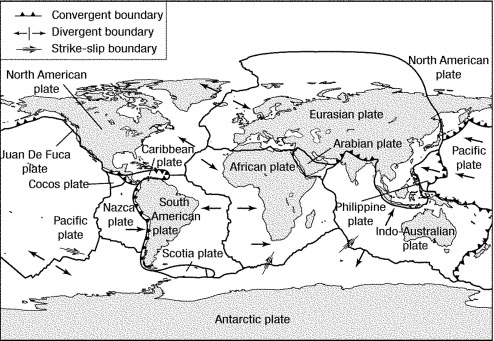1) Mid-oceanic ridges are sites with active volcanism, mild earthquakes, and:
a. they only have thin sediment cover because ocean floor is being newly formed.
b. the new crustal rocks consist of rocks of basaltic composition.
c. they are locations of hot water vents (called black smokers) on the seafloor.
d. all of the above.
2) The theory of plate tectonics helps explain the location of volcanoes and earthquakes. Which of these also describes the current theory of plate tectonics?
a. it combines elements of continental drift and seafloor spreading.
b. it suggests that the lithosphere is divided into pieces, called plates.
c. denser ocean crust sinks below less-dense continental crust along subduction zones.
d. all of the above.
3) A mid-ocean ridge is an example of what type of plate boundary?
a. convergent zone
b. divergent zone
c. transform zone
d. subduction zone
4) The youngest rocks on the ocean floor are typically located near what feature?
a. a mid-ocean ridge
b. a subduction zone
c. on an island arc
d. a deep-sea trench
5) A rift valley is evidence of which kind of plate boundary?
a. convergent boundary
b. transform boundary
c. divergent boundary
d. hotspot
6) What happens where an oceanic plate converges with a continental plate?
a. The denser oceanic plate slides on top of the less dense continental plate.
b. The denser oceanic plate slides under the less dense continental plate.
c. The less dense oceanic plate slides past the denser continental plate.
d. The less dense oceanic plate slides under the denser continental plate.
7) At what type of plate boundary are most high continental mountains formed?
a. convergent boundary
b. hotspots
c. divergent boundary
d. transform boundary
e. mid-ocean ridges
8) What kind of plate movement created the Himalayan Mountains?
a. convergence of oceanic crust with continental crust.
b. divergence between two continental crustal plates.
c. transform movement between oceanic and continental crustal plates.
d. convergence of two plates composed of continental crust.
9) According to the theory of plate tectonics:
a. the asthenosphere is divided into plates.
b. the lithosphere is divided into plates.
c. the asthenosphere moves over the lithosphere.
d. the asthenosphere is strong and rigid.
e. all of the above.
10) In plate tectonics theory, a plate can be made up of:
a. continental lithosphere only.
b. oceanic lithosphere only.
c. both continental and oceanic lithosphere.
d. both continental and oceanic asthenosphere.
11) What kind of plate boundary occurs where two plates grind past each other without destroying or producing new lithosphere?
a. divergent boundary
b. hotspots
c. convergent boundary
d. transform boundary
12) What type of boundary occurs where two plates move together, causing one plate to descend into the mantle beneath the other plate?
a. transform fault boundary
b. convergent boundary
c. divergent boundary
d. hotspots
13) Deep ocean trenches are associated with:
a. mid-ocean ridge systems.
b. transform fault boundaries.
c. subduction zones.
d. rift zones.
14) The Hawaiian Islands are associated with what type of volcanism?
a. intra-plate volcanism at a hotspot
b. subduction zone volcanism
c. volcanism at a divergent plate boundary
d. volcanism at a convergent plate boundary
15) Almost all deep-focus earthquake occur along or near what type of plate boundary?
a. convergent boundary
b. passive margin
c. transform boundary
d. divergent boundary
16) Which type of plate boundary is in the southern California region?
a. passive margin
b. divergent boundary
c. convergent boundary
d. transform boundary
17) Rift valleys, like the Great African Rift Valley, form as a result of:
a. crustal compression.
b. crustal extension.
c. stress and strain.
d. ductile deformation.
Questions 18 to 20 are related to the Plate Boundary Map below.

18) According to the Plate Boundary Map, what type of plate boundary occurs between the North American Plate and the Eurasian Plate?
a. transform boundary
b. divergent boundary
c. convergent oceanic-continental plate boundary
d. convergent oceanic-oceanic plate boundary
19) According to the Plate Boundary Map, what type of boundary occurs between the South American Plate and the Nazca Plate?
a. transform boundary
b. convergent continental-continental plate boundary
c. a convergent oceanic-continental plate boundary
d. convergent oceanic-oceanic plate boundary.
20) According to the Plate Boundary Map, which of the seven major lithospheric plates consists mostly of oceanic lithosphere?
a. Pacific Plate
b. Antarctic Plate
c. Indo-Australian Plate
d. South American Plate
|

